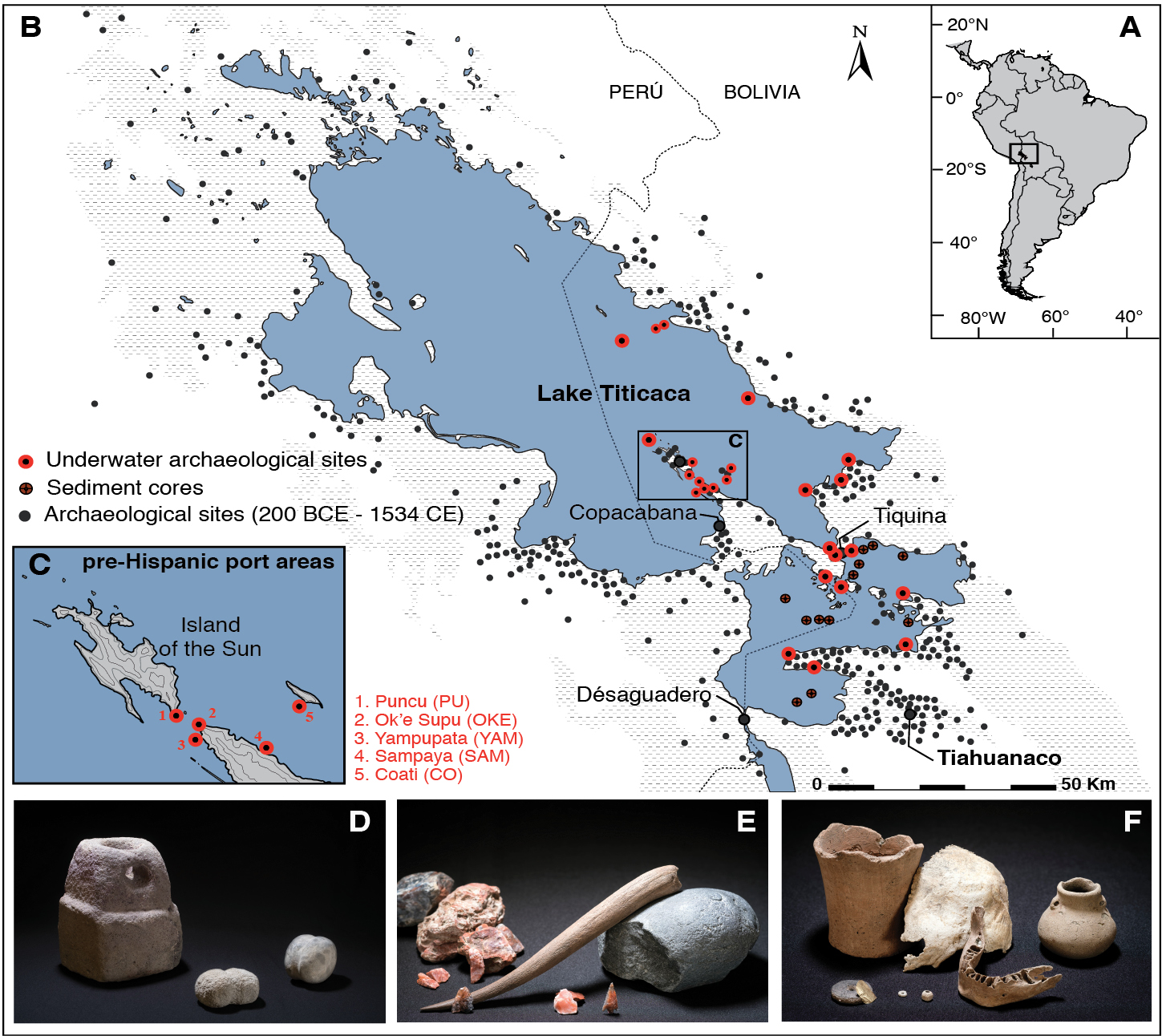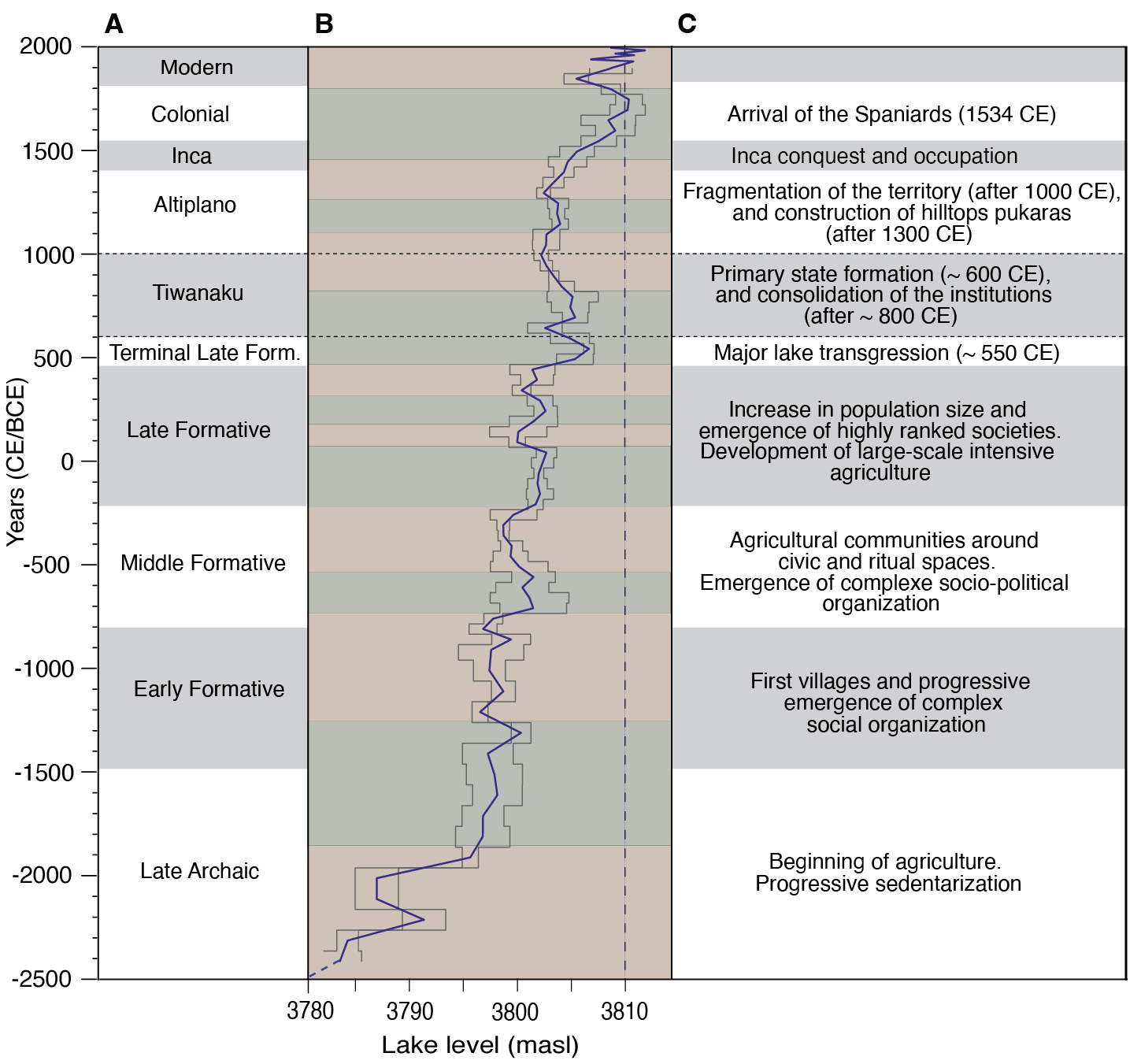- Home
- Publications
- PAGES Magazine
- Interactions Between Past Societies and Environmental Change In The Lake Titicaca Region (tropical Andes)
Interactions between past societies and environmental change in the Lake Titicaca region (tropical Andes)
Christophe Delaere, S. Guédron and S.C. Fritz
Past Global Changes Magazine
31(1)
18-19
2023
Over the millennia, complex and elaborate cultures have emerged in the Lake Titicaca region. Recent archaeological evidence and new environmental reconstructions spanning the last ~4500 years have enabled us to explore the interactions between cultural developments of past societies and the changing environment.
The history of societies is influenced by interactions between humans and their environment. This is particularly the case for communities of the high tropical Andes, who repeatedly experienced large amplitude changes in climate and the surrounding landscape.
Here we present recent underwater archaeological evidence and paleoenvironmental reconstructions compatible with archaeological timescales. We then focus on identifying and exploring the relation between major environmental changes and cultural innovations in the Lake Titicaca region to decipher potential relationships.
Lake Titicaca sediment: An archive of past climate change and human activities
Lake Titicaca’s sediment record preserves both natural variability and cultural-related signals (Guédron et al. 2021). Multiple studies have reconstructed water-level variability from diverse proxies (e.g. sedimentology, geochemistry, microfossils) and inferred fluctuations in moisture balance at the regional scale (Baker et al. 2001). In general, the temporal resolution of existing paleoenvironmental studies in Lake Titicaca was not high enough to be compared with archaeological studies.
A relatively novel approach in the last decade has been underwater archaeological studies which enabled the refinement of the dating of sediment layers at the archaeological timescale by the analysis of ceramic remains found buried in the sediment. For the first time, underwater archaeological remains and artefacts in Lake Titicaca’s sediment have shed light on the impact of water-level variation on human occupation of the land, and revealed the presence of an unknown, and now flooded, cultural landscape (Delaere 2017; Delaere 2020; Delaere and Guédron 2022) (Fig. 1a–b). Extensive underwater excavations integrating paleoenvironmental approaches have disclosed the presence of pre-Hispanic port areas (Fig. 1c–d), coastal workshop sites dedicated to manufacturing activities (e.g. leather, stone, and wool) (Fig. 1e), and pastoral and human areas that are currently submerged (Fig. 1f). Ritual offerings have also been identified underwater (Delaere et al. 2019; Delaere and Capriles 2020). These cultural artefacts differ, however, from other remains as they are intentional tributes, and not linked to environmental alteration events. Today, more than 25 underwater archaeological sites, mainly submerged coastal settlements, have been explored in Lake Titicaca (Fig. 1b) using underwater geoarchaeological tools (underwater excavations and sediment cores) to better understand the historical interactions between humans (e.g. settlement dynamics), and their changing environment (i.e. transgression and regression of the lake). Remnants of both the anthropogenic and natural ecosystems are perfectly interconnected and preserved in the lake sediments.
Environmental changes and cultural responses at Lake Titicaca
The combination of geological and archaeological methods has enabled the development of a new model of Lake Titicaca’s lake level variations at a resolution compatible with archaeological timescales (Fig. 2) (Guédron et al. 2023). Due to the gentle slopes of the southern Lake Titicaca basin, variation in lake-level of a few meters results in substantial changes in the exposure of surrounding land. Hence, over the past four millennia, human communities have witnessed multiple transgressions and regressions (up to ~5 m) of Lake Titicaca that have submerged, or opened areas for settlement and agriculture (Fig. 2b) (Delaere and Guédron 2022). Yet, ancient native populations in the lake basin undoubtedly had a well-developed knowledge of the local ecosystem and diversified the exploitation of resources in response to climate variability. In the case of agriculture, the succession of dry and wet periods induced long-term cultural responses that illustrate the great resilience of human communities (Bruno et al. 2021).
Increased precipitation led to the gradual rise in lake level from 2400 BCE onward (Fig. 2b). This climatic and environmental shift induced cultural changes and innovations within Lake Titicaca’s human communities. Some of them coincided with significant increases in lake-water level, such as the development of agriculture ca. 2000 BCE (Bruno 2014), farming communities organized around civic-ceremonial centers ca. 800 BCE (Hastorf 2003), or the first "fortified" cities, named pukaras, at the top of the slopes of the drainage basin ca. 1300 CE (Arkush 2008) (Fig. 2).
The emergence or disappearance of components of the Andean cultures were complex responses to diverse types of change. Some natural events promoted cultural responses in the short term, but cultural development was ultimately influenced by a multifactorial relationship that included both natural and societal criteria. At Lake Titicaca, the progressive rise in the lake level over the last ~4500 years was accompanied by cultural changes observed in the archaeological evidence (sedentarization, population expansion, emergence of social complexity, etc.). This is the case for the rapid rise of the lake during the Terminal Late Formative period (ca. 550 CE; Fig. 2b), which flooded large areas of arable land, and probably forced populations to abandon land near the shore, and take refuge in higher elevated regions (Guédron et al. 2023). These environmental changes had consequences for local societies. The emergence of the Tiwanaku culture (600 CE) that succeeded this natural event (550 CE) is the product of several factors (e.g. Marsh et al. 2019). At that time, the civic-ceremonial center of Tiahuanaco, a small center of local power south east of Lake Titicaca (Fig. 1b), had reached sufficient social, economic, and political maturity to take advantage of environmental and demographic changes, and establish a position of regional power over the entire lake basin in less than half a century. Later, around 800 CE, the destruction and reconstruction of part of the civic-ceremonial core of Tiahuanaco (Couture and Sampeck 2003) was a new, decisive turning point that promoted the "emergence of an elite class and the crystallization of a rigidly defined social hierarchy in Tiwanaku" (Janusek 2004). At the same time, the level of Lake Titicaca began to decline, which continued until the end of the Tiwanaku period (Fig. 2). Although these last two events were synchronous, the progressive decrease in the water level of the lake did not have irreversible consequences between 800 and 1000 CE due to the persistence of the Tiwanaku culture.
Human–environment interactions across a spectrum of environmental scenarios
The interaction between past societies and climate change has been the focus of research in the Andes for decades. The reevaluation of Lake Titicaca’s society and ecosystem allows us, with a new combination of approaches, to explore the nuances of human–environment interactions across a spectrum of environmental scenarios (high and low lake level). Prolonged drought, due to natural climate change, can lead to technological innovations in agricultural land management (e.g. irrigation, canalization, and raised fields), whereas lake transgressions (environmental alterations during highstand phases) involving the loss of large agricultural areas may induce cultural shifts (social and economic structure), which also affect land use and management. The time factor is important in the study of the relationship between natural and cultural signals. We can perceive, for the first time, the nuance between the short-term cultural responses (e.g. the exodus of a population that must abandon the flooding of a territory) and long-term cultural responses (reorganization of political, economic and religious institutions). The new chronological resolution allows us to identify different crisis situations in land management (natural action vs cultural reaction), in particular that of 550 CE, but the effective cultural response, whether positive (resilience) or negative (collapse), is calculated over time. Major regional cultural changes (Fig. 2c) coincided with significant rises in Titicaca’s lake level (Fig. 2b, green shading) but with an apparent delay of 50 to 200 years. This delay reflects the cultural long-term response to environmental alterations.
affiliation
1Centre de Recherches en Archéologie et Patrimoine, Université libre de Bruxelles (ULB), Brussels, Belgium
2Université Grenoble Alpes, Université Savoie Mont Blanc, CNRS, IRD, IFSTTAR, ISTerre, Grenoble, France
3Department of Earth and Atmospheric Sciences, University of Nebraska, Lincoln, USA
contact
Christophe Delaere: delaerechristophe gmail.com (delaerechristophe[at]gmail[dot]com)
gmail.com (delaerechristophe[at]gmail[dot]com)
references
Arkush E (2008) Lat Am Antiq 19: 339-373
Baker PA et al. (2001) Science 291: 640-643
Bruno MC (2014) Am Anthropol 116: 130-145
Bruno MC et al. (2021) Hum Ecol 49: 131-145
Delaere C (2017) J Marit Archaeol 12: 223-238
Delaere C, Capriles JM (2020) Antiquity 94 (376): 1030-1041
Delaere C, Guédron S (2022) World Archaeol 54: 67-83
Delaere C et al. (2019) Proc Natl Acad Sci 116: 8233-8238
Guédron S et al. (2021) Anthropocene 34: 100288
Guédron S et al. (2023) Proc Natl Acad Sci 120: e2215882120

